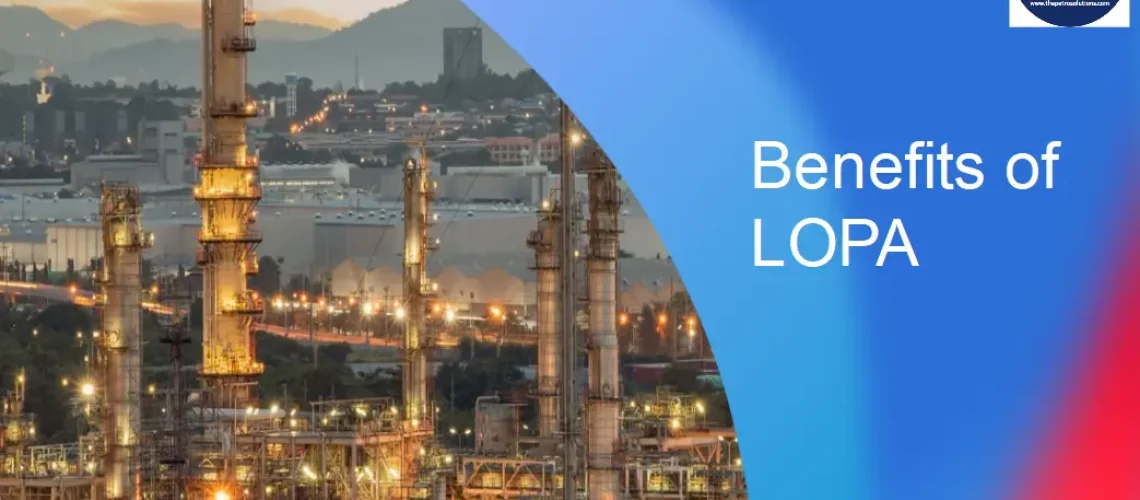Using simplified data, the Simplified LOPA technique analyses one initiating event and one consequence scenario. Despite its simplicity, it can consistently determine a semi-quantitative estimate of risk and list the IPLs for a process. LOPA has many benefits that justify investment by company management and risk analysts. However, as with most new tools, the benefits often cannot be fully appreciated until LOPA is applied to everyday problems. Some general benefits of LOPA include:
1. Time Efficiency:
LOPA requires significantly less time compared to quantitative risk analysis, making it particularly valuable for scenarios that are too complex for qualitative risk assessment.
2. Conflict Resolution in Decision-Making:
By offering a consistent and simplified framework for risk estimation, LOPA helps resolve decision-making conflicts. It provides a common language for discussing risk and offers a more robust decision-making basis than subjective or emotional arguments, such as “the risk is tolerable to me.” This is especially useful for organizations transitioning from qualitative to more quantitative risk methodologies.
3. Enhanced Hazard Evaluation Efficiency:
LOPA improves the efficiency of hazard evaluation meetings by enabling quicker judgments on risk scenarios.
4. Improved Scenario Identification:
LOPA facilitates the identification of more precise cause–consequence pairs, enhancing the overall understanding and documentation of risk scenarios.
5. Comparative Risk Analysis Across Units or Plants:
Using a standardized approach across the organization, LOPA enables the comparison of risk levels between different units or plants.
6. Defensible Risk Judgments:
Compared to qualitative methods, LOPA provides more defensible risk judgments due to its rigorous documentation and the assignment of specific values to the frequency and consequence aspects of each scenario.
7. Support for ALARP Determination and Regulatory Compliance:
LOPA aids organizations in determining whether a risk is “As Low As Reasonably Practicable” (ALARP), helping meet specific regulatory requirements.
8. Uncovering Insufficient Safeguards:
LOPA identifies operations and practices previously thought to have adequate safeguards. Upon detailed analysis, it often reveals risks that exceed tolerable levels, prompting the need for additional risk mitigation measures.
9. Focused Maintenance and Training Priorities:
LOPA helps organizations determine which safeguards to prioritize during operation, maintenance, and training. Many companies concentrate their inspection, testing, and preventive maintenance efforts on the IPLs identified during LOPA. Non-IPL safeguards are often subjected to less rigorous maintenance schedules or allowed to run to failure, optimizing resource allocation.
10. Straightforward and Practical
Simplified LOPA streamlines the process by focusing on a single initiating event and its corresponding consequence scenario, relying on basic estimations for input data. This approach ensures it is accessible for plant personnel to grasp and straightforward for PHA facilitators to implement. Nevertheless, its simplicity poses a challenge, as it may overlook important nuances, potentially leading to inaccurate risk assessments, either by overestimating or underestimating the risks involved.
11. Determines Functional Specification or SIF and SIL Requirements
Simplified LOPA is a widely accepted semi-quantitative risk assessment method. It efficiently determines if a Safety Instrumented Function (SIF) is necessary and identifies the corresponding Safety Integrity Level (SIL) target. However, it tends to provide a more conservative estimation of residual risk and SIL requirements compared to Quantitative LOPA.
LOPA provides a clear basis for the functional specification of Independent Protection Layers (IPLs), aligning with standards such as ISA S84.01, IEC 61508, and IEC 61511.
12. Identifies Ways to Improve the Risk Reduction of Existing Safeguards
Simplified LOPA can help determine whether a safeguard qualifies as an Independent Protection Layer (IPL) and guide improvements in its design or management for enhanced effectiveness. For instance, if an alarm and operator intervention safeguard fails due to the absence of operating procedures for the alarm response, such procedures can be developed alongside operator training. This ensures the safeguard becomes a valid IPL with measurable risk reduction, helping to lower plant risks without adding new equipment.
13. Helps Ensure Risk Reduction Will Be Maintained
LOPA requires all IPLs to be auditable, ensuring that overall plant risk reduction is preserved over time. This is achieved through maintenance, testing, and policy updates to the IPL equipment. For example, if a scenario’s non-SIF IPLs achieve a risk reduction of 100 and a SIL 1 SIF is required, the target SIL would increase to 3 if the risk reduction from the non-SIF IPLs is not maintained.
14. Assists in Prioritizing Plant Equipment, Alarms and Instruments
LOPA helps to identify the safety-critical devices in the process plant. Simplified LOPA aids in prioritizing critical plant components by assigning risk reduction only to safeguards that meet IPL criteria. By doing so, it highlights equipment, procedures, and alarms crucial to maintaining plant safety. Many organizations consider IPL-related equipment as “critical” in their mechanical integrity programs and plant maintenance philosophy, focusing efforts on a subset of critical systems. Additionally, identifying procedures and alarms related to operator intervention IPLs helps streamline operator training.





